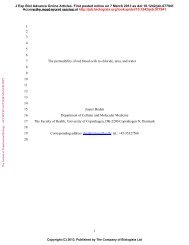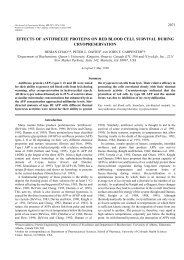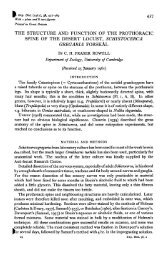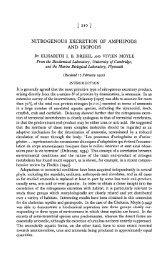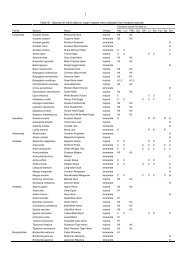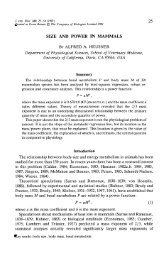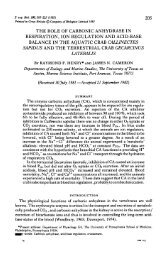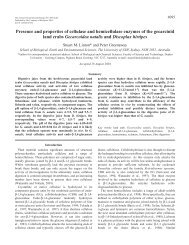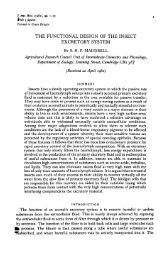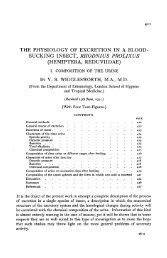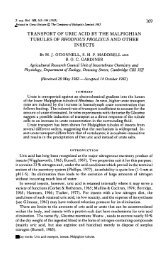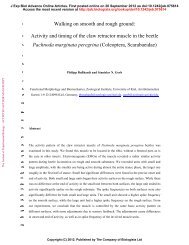the excretory system of the stick insect, dixippus morosus
the excretory system of the stick insect, dixippus morosus
the excretory system of the stick insect, dixippus morosus
You also want an ePaper? Increase the reach of your titles
YUMPU automatically turns print PDFs into web optimized ePapers that Google loves.
188 J. A. RAMSAY<br />
<strong>the</strong>se granules is calcium carbonate. The egg shells <strong>of</strong> phasmids are hardened with<br />
calcium oxalate (Moscona, 1950). Since <strong>the</strong> inferior tubules with <strong>the</strong>ir dilatations<br />
and granules are absent in <strong>the</strong> nymph and poorly developed in <strong>the</strong> male, and since<br />
<strong>the</strong> granules appear to be reduced in quantity during fasting (egg production<br />
continuing), it seems likely that <strong>the</strong>y are a calcium reserve which can be drawn<br />
upon to provide material for <strong>the</strong> egg shells.<br />
(c) Appendices <strong>of</strong> <strong>the</strong> midgut. These tubules are narrower (c. 50/i) than <strong>the</strong> o<strong>the</strong>rs<br />
and are uniform throughout <strong>the</strong>ir length. There is a well-developed brush border<br />
and <strong>the</strong> inner margin can be brought to focus (Fig. 3 c). It is perhaps less sharply<br />
defined than <strong>the</strong> scalloped edge <strong>of</strong> <strong>the</strong> 'wabensaum' in Rhodnius (Wigglesworth,<br />
1931ft), but more definite than <strong>the</strong> edge <strong>of</strong> <strong>the</strong> border as seen at <strong>the</strong> tip <strong>of</strong> <strong>the</strong><br />
superior tubule (Fig. 3 a). No granules have been seen in <strong>the</strong>se tubules.<br />
Wigglesworth has reported that in Rhodnius <strong>the</strong> normal histological appearance<br />
<strong>of</strong> <strong>the</strong> tubules is not preserved in artificial media. The same is true <strong>of</strong> <strong>the</strong> tubules<br />
<strong>of</strong> <strong>the</strong> <strong>stick</strong> <strong>insect</strong> in all artificial media as yet tested. A Ringer solution approximating<br />
to haemolymph in composition has been prepared (Ramsay, 1955). Within<br />
an hour or two after being placed in Ringer <strong>the</strong> walls <strong>of</strong> <strong>the</strong> tubules begin to lose<br />
<strong>the</strong>ir characteristic bright appearance. The striations <strong>of</strong> <strong>the</strong> brush border become<br />
fainter and <strong>the</strong> border eventually disintegrates. The appearance <strong>of</strong> <strong>the</strong> nuclei<br />
changes with what appears to be <strong>the</strong> separation <strong>of</strong> a coagulum from a clear fluid<br />
within <strong>the</strong> nuclear membrane (Fig. 3d). A space appears between <strong>the</strong> cells and <strong>the</strong><br />
basement membrane which is clearly visible only under <strong>the</strong>se conditions, and after<br />
5 or 6 hr. a disintegrating mass <strong>of</strong> cells fills <strong>the</strong> lumen. The contraction <strong>of</strong> <strong>the</strong><br />
muscular elements in <strong>the</strong> walls continues for some time longer.<br />
Table 1. Relative quantities <strong>of</strong> mineral bases as percentage<br />
<strong>of</strong> toted mineral base expressed in equivalents<br />
Na<br />
K<br />
Ca<br />
Mg<br />
Privet<br />
leaves<br />
(1)<br />
13<br />
35<br />
46<br />
6<br />
100<br />
Nymph<br />
faeces<br />
(2)<br />
9<br />
33<br />
Si<br />
7<br />
100<br />
Adult<br />
faeces<br />
(3)<br />
EXCHANGE OF MINERAL BASES<br />
The <strong>insect</strong> takes in sodium, potassium, calcium and magnesium in <strong>the</strong> proportions<br />
in which <strong>the</strong>y are present in privet leaves (Table 1, col. 1), and should presumably<br />
eliminate <strong>the</strong>m in <strong>the</strong> same proportions. In <strong>the</strong> case <strong>of</strong> <strong>the</strong> nymph elimination is<br />
entirely by way <strong>of</strong> <strong>the</strong> faeces, and it is found that in <strong>the</strong> faeces <strong>of</strong> <strong>the</strong> nymph <strong>the</strong><br />
four bases are present in much <strong>the</strong> same proportions as in <strong>the</strong> leaves (Table 1,<br />
col. 2). In <strong>the</strong> case <strong>of</strong> <strong>the</strong> adult female <strong>the</strong> eggs constitute a second channel <strong>of</strong><br />
elimination. The rate <strong>of</strong> egg production is considerable and in terms <strong>of</strong> ash a somewhat<br />
greater weight is eliminated as eggs than as faeces. It is difficult, however, to<br />
11<br />
66 8<br />
15<br />
100<br />
Eggs<br />
(4)<br />
10<br />
5<br />
83 2<br />
100




